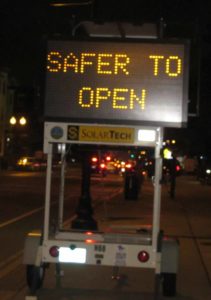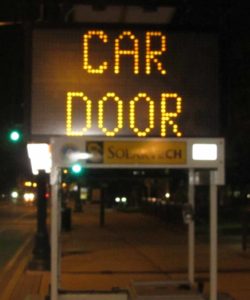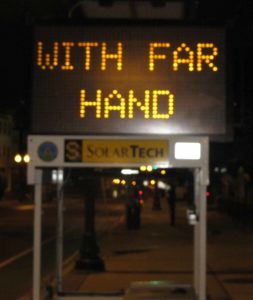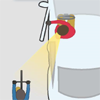


HOW IT HAPPENED - ANTI- DOORING 'DUTCH REACH' MEME GONE VIRAL
The adjacent mobile electronic traffic sign launched the 'Dutch Reach'!*
Electronic messages here displayed were posted by the City of Somerville, MA's Police Department in early September 2016, just eleven weeks after the dooring death of Amanda in neighboring Cambridge which triggered the Dutch Reach Project. The Project had circulated a list of suggested 'haiku' for posting on mobile electronic traffic signs, and the City of Somerville's Deputy Chief of Police Steve Carrabino and staff devised and displayed the version displayed above in early September 2016.
Stuck in traffic, a Boston Globe reporter Steve Annear saw the sign, discovered the 'Dutch Reach' effort behind it, and wrote the very first news story about the Dutch Reach campaign. It appeared September 8, 2016 in the Boston Globe's online edition with the headline: "To avoid 'doorings,' this cyclist wants drivers to do the 'Dutch Reach', and trended among the top stories that day.
Ben Fox, a writer for Outside Online Magazine based in Santa Fe, noted the Globe story online, and pitched it to his editors. Of its own initiative and unbeknownst to the Project, Outside Online editors and videographer Marie Sullivan of an afternoon produced Outside's "The Dutch Reach - Safe For Work" video (posted 9/19/16 on Outside's website & 9/21 on YouTube). Their video went viral, garnering over one million views in one month! Two weeks later, Marco Werman of WGBH & PRI/BBC World Service's The World produced a radio interview with the Dutch Reach Project's founder and distributed it to hundreds of stations across North America, linking to the video in its online/archived edition. The broadcast was soon relayed to Europe and beyond.
The Dutch Reach method was now spreading world-wide with over 3.4 million views of the Outside Online video on its two original You Tube portals alone, as of 29 Oct. 2018. Google-search 'Dutch Reach' to find a scores if not hundreds or more sites carrying Outside's or other 'Reach' videos, graphics, and reporting the method and sharing the meme, including BBC World Service/PRI, Upworthy, 99percentinvisible, CleanTechica, and diverse online & social media sites in dozens of countries including Canada, Australia, United Kingdom, Ireland, South Africa, Belgium, Netherlands, Austria, Germany, Denmark, Sweden, Romania, Italy, Spain & Japan (1, 2). It has progressed across cycling and safer streets organizations and clubs, auto dealers, radio stations, plaintiff's attorneys, insurance companies, as well on general news outlets, TV stations, more so as it has been adopted by major road safety organizations and a growing number of local, state and national traffic and transportation departments and governments. [For more comprehensive lists & new sightings see Wikipedia > Dutch Reach, Coverage by Country or Language, and more or less chronologically see Current News and it preceding archives or the updates in About.
In November 2016, Canadian Member of Parliament Joel Lightbound took to the floor and called upon Canadian citizens to re-train themselves this winter in using the Dutch Reach in time for the return of spring bicycling. He spoke movingly of the death of his good friend by a dooring in August 2015 while working on Lightbound's campaign. He displayed, and is now distributing bilingual stickers to constituents based on the Dutch Reach Project's homepage line drawing. Prime Minister Justin Trudeau endorsed Lightbound's campaign by re-tweeting his graphic call to action.
In December the 'Reach' got noticed in Britain after the Conservative's Minister of Transport Chris Grayling was caught on video dooring a cyclist in Parliament Square. The charity Cycling UK then incorporated the Dutch Reach into its ongoing national anti-dooring campaign. [See account at bottom of UK coverage here.]
AND WHY IT'S HAPPENING
Explanation and credit for the late and lately arrived popularity of the Dutch far hand method and meme are apparently of social and historical interest to some. (See: Historically Speaking)
Here are at least six reasons why the idiomatic and quirky meme 'Dutch Reach' and its referent anti dooring fix is now getting known, used and advocated across the globe.
1) Necessity: Cyclists' real and widely felt fear of sudden smash ups with flung car doors drives interest. Serious demand for personal safety has found a brilliantly simple, free & universal solution in the far hand method, aka ‘Dutch Reach’, unknown to most all before.
2) No name. No ID. No go.: Naming the far hand habit was way overdue. It’s dissemination had been crippled by anonymity. Once blessed with a short - and dicey - tag, it got legs, and could even be socially 'marketed,' informally and deliberately.
Nameless, no one talked about it, heard about it, could search, find, study, teach or push it. So this 'duh' 50 year old commonsense fix hardly got beyond Holland's physical and linguistic border. The Dutch couldn't imagine other people doing otherwise: That the rest of the world's 'commonsense' was the near hand opposite to theirs. And so the Dutch safe roads and bicycling ambassadors never touted it along with the Netherlands' other street cures for bicyclist death or injury.
3) Name appeal: In English - and many other languages where it is being adopted virtually 'as is' - this novel coined term is puzzling, unusual and memorable. It is short, punchy, has consonance, and a curious whiff of outre connotations, ie. media bait. So branded it gave gamy trend-setters something to play with. Which resulted in...
4) Smut, Smirks, & Videotape: While the Boston Globe newspaper first put ‘Dutch Reach’ in prim print, and PRI/BBC first radioed this term to The World, it was Outside Online's faux risque video "The Dutch Reach - Safe For Work" that sent smiles & waves of "wow! so obvious, simple!" around the e-globe. Other online outlets also picked up on the undercurrent, though for older audiences and staider media missed entirely the " Not Safe for Work" [NSFW] allusions read into the coinage, Dutch Reach. For more on 'Dutch Reach's quirky or questionable reputation, See note below. [Disclosure: The retired doctor who named the practice was among the elder naifs: Dutch Reach was chosen as a straightforward combination of attribution and action. Perplexed by the smirks and NSFW acronym, he only learned of the suggestive twist weeks after Outside's video went viral],
5) Dry grass, arson & advocacy: With bicycles booming, coming on to reclaim a safe fair share of the roads too long ceded to cars, tinder was dry and getting drier. After a number of earlier strikes to set it going -- in Toronto & Montreal Ca, New Haven CT USA, and Victoria AU -- it took just a lucky bit of wordsmithing to spark this prairie fire. Even the Dutch Reach Project -- website-less at the time of peak conflagration -- was left far behind as word has spread.
6) You and me: Now the Dutch Reach has some significant public and grassroots advocacy recognition - and drop down menus full of useful copy and graphics. We know that dooring has a simple universal free behavioral fix, which we all can teach and use. 'How to' & 'What with' has and is now being created and shared on this site.
Let's keep it going! We can each do a bit. Please help share, teach and establish the Dutch Reach as official best practice and habit where you live and bike.
Note on SFW v NSFW & outre mis-attributions:
Not safe for work (NSFW) is modern code for computer screen content, typically video or graphic, often pornograhic, discovered being viewed at work, could cause problems for the viewer. SFW content is innocuous.
As explained above, the term "Dutch Reach" concisely labels two key attributes of the method. 1) Its unique aspect is reaching across to open, rather than pushing with the near hand. 2) Its most likely provenance and/or place of predominant historical use, is the Netherlands, and it was due to Dutch citizens testimony that brought the method came to the coiner's attention and then found initial confirmation in the New York Times report of 2011.
The 'read in' NSFW connotations however came as a surprise. The Dutch are a people. The Dutch reach the soccer finals. Dutch chocolate, tulips, rolls and ovens are usually unexceptional items. Etymologists report that several uses of Dutch as an adjectival slur are due to old British alarm or animosity regarding their Dutch in times of war. Dutch uncle, going dutch, etc. are examples.
Reach is of course a very common and also innocuous term, but is also used to when describing a certain sexual act. Other terms when joined to dutch used as a slur or to suggest locker room behavior or talk, was apparently the source of willing confusion for many wired Millenials who were teased by Outside Online's joke. For those still interested in learning more, find a slang dictionary online and search!
Those with higher brows will be amused and enlightened iby Rose Jacobs' Lingua Franca blog hosted by The Chonicle of Higher Education: Have You Heard of ‘Dutch Reach’? On Collision and Derision in Language.



Dutch Reach Name & History
January 10, 2017: The idiom unraveling website Idiomation - Historically Speaking - researched the origin of the name Dutch Reach with an unsurprising result.
Of other minor historical note, the first print inkling of this campaign was a letter to the editor published by Cambridge Wicked Local: Driver retraining essential in wake of Cambridge cyclist's death, June 29, 2016. The term 'Dutch Reach' was coined and used as an email subject heading for outreach and research correspondence during the incubation period prior to the 9/8/16 Boston Globe story, which first put it in print.
As noted elsewhere on this website, as best is known to this author to date, the Dutch far hand method has never had a proper name in the Netherlands nor elsewhere, being considered just 'how you open the car door' or referred to with a physical description, ie. open with your right (or far) hand, reach across to the door latch with your opposite hand, etc.
By whom, how this method was discovered or invented, or its merits recognized and adopted, seems lost even to the Dutch. While the method was not incorporated directly into NL's official traffic code, its exacting requirement to avoid endangering oncoming traffic, including bicyclists, made the far hand method the de facto practice taught by driver training instructors in order to pass the licensing exam. The Netherlands does not issue a driver's manual or handbook. Rather it leaves it to the instructors and driving schools to develop curricula & resources for study and practice. How the code was written regarding safe exiting, and how the road test became so stringent in NL, was not known to this writer. One may expect a history has or could be written about the public demand and political forces which led to the current code, and its implementation in licensing tests, policing, and judicial actions.
The methods very namelessness and commonsense taken-for-granted quality during 50 years of Dutch use helps explain its failure to travel outside Holland, at least not very far. With no name and no passport, it went unremarked, un-indexed, and hardly spoken of, let alone promoted to foreigners as part of the Netherlands celebrated repertoire of road safety culture and infrastructure innovations. This admirable state of affairs - Holland's now enviable peace on the streets was not God-given to the Dutch. For 45+ years ago there was vast carnage on Holland's roads. Only sustained social protest and reforms reversed their astounding vehicular homicide rate. See Stop de Kindermord movement of 1973.
What is currently known to this American English speaking web searcher is that the first found reference in mainstream print to the far hand method may be credited to a seminal 2011 New York Times opinion piece by Russell Shorto. He quoted bicycling history expert Professor Ruth Oldenziel of Eindhoven University, NL who first relayed this novel far hand method to America. It was picked up three weeks later in an obscure Nudge blog post. It next appears in main-stream media print in the Boston Globe in 2013 due to Martine Powers' on the ground reporting in the Netherlands. As before, it was described as a move rather than cited with a name.
The method was known to writer and cycling safety advocate Lloyd Alter of Toronto who encouraged its use for years (perhaps as far back as 2006?) he but never labeled it. It has been percolating quietly in North America in several cycling cities where dooring has become a common concern. It was and is mentioned but not emphatically promoted in Montreal's 'Une Porte Une Vie' anti-dooring campaign (2014 to the present). It has also gained a foothold in New Haven Connecticut, USA and more recently in San Francisco (2015 to the present). [See: Prior Reach Reports & Practice.]
It is worth noting that in 2014 the far hand method was specifically promoted to drivers in New Haven. That city's traffic czar learned of the method from a local bike shop - Devil's Gear. A recently doored Yale College senior was enlisted who leafleted parked cars in the downtown business district with fliers titled "Doors Hurt" which called on drivers to 'reeducate' themselves to use the European "reach across" or "Amsterdam method.



Debate on Actual Status & Use of Far Hand Method in NL Today
In the course of researching the far hand method, questions have arisen whether this far hand method is in fact commonly practiced or at all, or if it is official standard practice - (it is not officially required but apparently due to the strict licensing test the method has for many driving schools & instructors been considered de rigueur for successful passage of the safe exiting requirement, so much so that even a Dutch road safety expert has been quoted as to its being official teaching). However use of the method, it now appears, is presently not as exclusive a Dutch practice as this writer first believed. This section addresses these issues.
Searching the now extensive harvest of Google Search 'finds' for "Dutch Reach" [1/16/17, 4.5 months after its e-print debut in the Boston Globe, 9/8/16] it appears that the far hand method is also being practiced to some unknown but likely unofficial extent in Belgium, Denmark, Germany, France and Sweden. [If you, dear reader, can document popularity or official status beyond NL, please send it along to this site via Contact, and it will be posted.]
And on the contrary, some anecdotal sources of Dutch nationality, or foreigners residing in NL, tourists, or even an occasional Dutch bicycling proponent are unfamiliar with the practice and its quasi code status in NL, claiming they had never heard of it, nor was it part of their driver training or road test experience.
Of course some say they had "never even heard of the 'Dutch Reach' " before. Indeed, this is entirely true! - the move only got e-named 'Dutch Reach' September 8, 2016 in english in America!
But on this latter point, there does seem to be some justified confusion or disagreement. While the technique is not specified in the NL traffic code, it has been instructed by various driving schools and prescribed in the foremost Driving Theory book in NL for decades, and is still being tested for by some official examiners on the licensing road test in NL.
[For recently found documentation on the origins, spread, teaching and current use of the far hand method in NL see: Is the ‘Reach’ Method Really Dutch? Yes!]
Explanations for the skepticism and confusion among contemporary Dutch citizens may be suggested. There is individual forgetfulness. For who truly remembers what was in the driver training manual, on the written exam or the road test years ago?
Apparently there is societal loss of historical memory as well since the taming of massive Dutch road carnage of the 60's & '70's. . In Holland in 1973 there where 3200 traffic deaths each year, 400 - 500 being children. Now despite a 1/3rd rise in population there were a total of 584 (one fifth as many) deaths by recent annual tally. The Dutch road users are now so considerate of each other and their bike/ped infrastructure improvements so vast and effective,, that there were only 2 dooring fatalities reported in the most recent year. So the practice may have indeed decline in NL as conditions have so improved and younger generations experience less communal pressure to use it.
